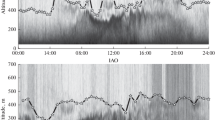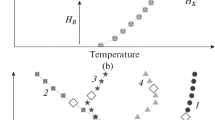Abstract
Results of comparing model estimates of the mixing layer height in the boundary layer of the atmosphere under conditions of ground inversions of air temperatures with experimental estimates of the height of the intense turbulent heat exchange layer are presented. Experimental data necessary for these estimates are obtained using a temperature-wind complex including a meteorological acoustic locator (sodar), a meteorological temperature profiler, and ultrasonic anemometer-thermometers. It is shown that the mixing layer height calculated by the model formulas under conditions of ground inversions of temperature is as a rule significantly less than the height of the turbulent heat exchange layer.







Similar content being viewed by others
REFERENCES
S. L. Odintsov, V. A. Gladkikh, A. P. Kamardin, and I. V. Nevzorova, “Height of the region of intense turbulent heat exchange in a stably stratified atmospheric boundary layer: Part 1—Evaluation technique and statistics,” Atmos. Ocean. Opt. 34 (1), 34–44 (2021).
S. L. Odintsov, V. A. Gladkikh, A. P. Kamardin, and I. V. Nevzorova, “Height of the region of intense turbulent heat exchange in a stably stratified boundary layer of the atmosphere. Part 2: Relationship with surface meteorological parameters,” Atmos. Ocean. Opt. 34 (2), 117–127 (2021).
A. P. Kamardin, V. A. Gladkikh, V. P. Mamyshev, I. V. Nevzorova, S. L. Odintsov, and I. V. Trofimov, “Estimation of the height of intense turbulent heat exchange layer in the stably stratified atmospheric boundary layer,” Proc. SPIE—Int. Soc. Opt. Eng. 11560 (2020). https://doi.org/10.1117/12.2574268
S. L. Odintsov, V. A. Gladkikh, A. P. Kamardin, and I. V. Nevzorova, “Determination of the structure characteristic of refractive index of optical waves in the atmospheric boundary layer with remote acoustic sounding facilities,” Atmosphere 10 (11) (2019). https://doi.org/10.3390/atmos10110711
H. Richardson, S. Basu, and A. A. M. Holtslag, “Improving stable boundary-layer height estimation using a stability-dependent critical bulk Richardson number,” Bound.-Lay. Meteorol. 148 (1), 93–109 (2013). https://doi.org/10.1007/s10546-013-9812-3
Y. Zhang, Z. Gao, D. Li, Y. Li, N. Zhang, X. Zhao, and J. Chen, “On the computation of planetary boundary-layer height using the bulk richardson number method,” Geoscie. Model Development 7, 2599–2611 (2014). https://doi.org/10.5194/GMD-7-2599-2014
M. C. Coen, C. Praz, A. Haefele, D. Ruffieux, P. Kaufmann, and B. Calpini, “Determination and climatology of the planetary boundary layer height above the Swiss plateau by in situ and remote sensing measurements as well as by the COSMO-2 model,” Atmos. Chem. Phys. 14, 13205–13221 (2014). https://doi.org/10.5194/acp-14-13205-2014
S. Zilitinkevich and A. Baklanov, “Calculation of the height of the stable boundary layer in practical applications,” Bound.-Lay. Meteorol. 105 (3), 389–409 (2002).
A. M. Holdsworth and A. H. Monahan, “Turbulent collapse and recover in the stable boundary layer using an idealized model of pressure-driven flow with a surface energy budget,” J. Atmos. Sci. 76 (5), 1307–1327 (2019).
I. Pietroni, S. Argentini, I. Petenko, and R. Sozzi, “Measurements and parametrizations of the atmospheric boundary-layer height at Dome C, Antarctica,” Bound.-Lay. Meteorol. 143 (1), 189–206 (2012).
V. A. Banakh, I. N. Smalikho, and A. V. Falits, “Determination of the height of the turbulent mixing air layer based on estimation of the parameters of wind turbulence from lidar data,” Opt. Atmos. Okeana 34 (3), 169–184 (2021).https://doi.org/10.15372/AOO20210303
H. Sun, H. Shi, H. Chen, G. Tang, C. Sheng, K. Che, and H. Chen, “Evaluation of a method for calculating the height of the stable boundary layer based on wind profile lidar and turbulent fluxes,” Remote Sens. 13, 3596 (2021). https://doi.org/10.3390/rs13183596
M. Huang, Z. Gao, S. Miao, F. Chen, M. A. LeMone, J. Li, F. Hu, and L. Wang, “Estimate of boundary-layer depth over Bejing, China, using Doppler lidar data during SURF-2015,” Bound.-Lay. Meteorol. 162 (3), 503–522 (2017). https://doi.org/10.1007/s10546-016-0205-2
T. Zhong, N. Wang, X. Shen, D. Xiao, Z. Xiang, and D. Liu, “Determination of planetary boundary layer height with lidar signals using maximum limited height initialization and range restriction (MLHI-RR),” Remote Sens. 12, 2272 (2020). https://doi.org/10.3390/rs12142272
S. Kotthaus, M. Haeffelin, M.-A. Drouin, J.-C. Dupont, S. Grimmond, A. Haefele, M. Hervo, Y. Poltera, and M. Wiegner, “Tailored algorithms for the detection of the atmospheric boundary layer height from common automatic lidars and ceilometers (ALC),” Remote Sens. 12, 3259 (2020). https://doi.org/10.3390/rs12193259
J. Cyrys, M. Pitz, C. Munkel, and P. Suppan, “On a relation between particle size distribution and mixing layer height,” Proc. SPIE—Int. Soc. Opt. Eng. 8177, 81770 (2011). https://doi.org/10.1117/12.898194
R. Dang, Y. Yang, X. Hu, Z. Wang, and S. Zhang, “A review of techniques for diagnosing the atmospheric boundary layer height (ABLH) using aerosol lidar data,” Remote Sens. 11, 1590 (2019). https://doi.org/10.3390/rs11131590
H. Zhang, X. Zhang, Q. Li, X. Cai, S. Fan, Y. Song, F. Hu, H. Che, J. Quan, L. Kang, and T. Zhu, “Research progress on estimation of the atmospheric boundary layer height,” J. Meteorol. Res. 34 (3), 482–498 (2020). https://doi.org/10.1007/s13351-020-9910-3
S. Emeis, K. Schafer, C. Munkel, R. Friedl, and P. Suppan, “Comparison of different remote sensing methods for mixing layer height monitoring,” Proc. SPIE—Int. Soc. Opt. Eng. 7827, 782707–01 (2010). https://doi.org/10.1117/12.865108
P. Seibert, F. Beyrich, S.-E. Gryning, S. Joffre, A. Rasmussen, and P. Tercier, “Review and intercomparison of operational methods for the determination of the mixing height,” Atmos. Environ. 34 (3), 1001–1027 (2000).
S. S. Zilitinkevich, Yu. I. Troitskaya, E. A. Mareev, and S. A. Tyuryakov, “Theoretical models of the height of the atmospheric boundary layer and turbulent entrainment at its upper boundary,” Izv., Atmos. Ocean. Phys. 48 (1), 133–142 (2012).
G. J. Steeneveld, B. J. H. van de Wiel, and A. A. M. Holtslag, “Diagnostic equations for the stable boundary layer height: Evaluation and dimensional analysis,” J. Appl. Meteorol. Climatol. 46 (2), 212–225 (2007).
V. A. Gladkikh, I. V. Nevzorova, and S. L. Odintsov, “Structure of wind gusts in the surface air layer,” Opt. Atmos. Okeana 32 (4), 304–308 (2019). https://doi.org/10.15372/AOO20190408
A. P. Kamardin, V. A. Gladkikh, S. L. Odintsov, and V. A. Fedorov, “Meteorological acoustic Doppler radar “VOLNA-4M-ST”,”Pribory, No. 4, 37–44 (2017).
E. N. Kadygrov and I. N. Kuznetsova, Guidelines for the Use of Microwave Profiler Measurements of Temperature Profiles in the Boundary Layer: Theory and Practice (Fizmatkniga, Dolgoprudnyi, 2015) [in Russian].
E. N. Kadygrov, E. V. Ganshin, E. A. Miller, and T. A. Tochilkina, “Ground-based microwave temperature profilers: Potential and experimental data,” Atmos. Ocean. Opt. 28 (6), 598–605 (2015). https://doi.org/10.1134/S102485601506007X
V. A. Gladkikh and A. E. Makienko, “Digital ultrasonic weather station,” Pribory, No. 7, 21–25 (2009).
S. Odintsov, E. Miller, A. Kamardin, I. Nevzorova, A. Troitsky, and M. Schröder, “Investigation of the mixing height in the planetary boundary layer by using sodar and microwave radiometer data,” Environments 8 (115) (2021). https://doi.org/10.3390/environments8110115
M. Yu. Arshinov, D. B. Belan, D. K. Davydov, D. E. Savkin, T. K. Sklyadneva, G. N. Tolmachev, and A. V. Fofonov, “Mesoscale differences in the ozone concentrations in the surface air layer in Tomsk region (2010–2012),” in Trudy IOFAN (General Physics Institute, Moscow, 2015), vol. 71, pp. 106–117 [in Russian].
A. P. Kamardin, I. V. Nevzorova, and S. L. Odintsov, “Statistics of air temperature inversions in the atmospheric boundary layer,” Proc. SPIE—Int. Soc. Opt. Eng. 11916 (2021). https://doi.org/10.1117/12.2602482
A. P. Kamardin, V. A. Gladkikh, A. S. Dervoedov, I. V. Nevzorova, S. L. Odintsov, and V. A. Fedorov, “Relationship between vertical and horizontal turbulent heat fluzes in the atmospheric boundary layer,” in Proc. of the XXV International Symposium “Atmospheric and Ocean Optics. Atmospheric Physics,” June 30–July 5, 2019, Novosibirsk (Publishing House of IAO SB RAS, Tomsk, 2019), pp. D263–D266. https://symp.iao.ru/ files/symp/aoo/25/D.pdf.
V. A. Gladkikh, S. L. Odintsov, and I. V. Nevzorova, “Heat fluxes in the surface air layer with decomposition of initial components onto different scales,” Atmos. Ocean. Opt. 34 (6), 668–681 (2021). https://doi.org/10.1134/S1024856021060130
V. A. Gladkikh, I. V. Nevzorova, and S. L. Odintsov, “Special cases of vertical turbulent heat fluxes at close altitudes n the surface air layer in winter,” in Proc. of the XXVII International Symposium “Atmospheric and Ocean Optics. Atmospheric Physics, July 5–9, 2021, Moscow (Publishing House of IAO SB RAS, Tomsk, 2021), p. D285–D288. https://symp.iao.ru/files/symp/ aoo/27/D.pdf.
ACKNOWLEDGMENTS
The experimental data were obtained using the temperature-wind complex which is part of the Common Use Center “Atmosphere” of Institute of Atmospheric Optics, Siberian Branch, Russian Academy of Sciences.
Author information
Authors and Affiliations
Corresponding author
Ethics declarations
The authors declare that they have no conflicts of interest.
Additional information
Translated by A. Nikol’skii
APPENDIX
APPENDIX
Calculations of the mixing layer height hS by formulas (1) and (5) require satisfying the condition Q < 0 W/m2 (first of all, for calculations by formula (5)). In all calculations we used results of measurements of the heat flux Q at a height of 10 m. However, in the analysis of experimental data, it was found that the antiphase effect of fluxes Q was observed in January 2021 in the ground layer at close levels of 10 and 5 m (the second Meteo-2 UMS simultaneously operated at that height). It means the following: the condition Q(10) > 0, which excludes the possibility of calculating hS by formulas (1) and (5), can be satisfied at a height of 10 m and, while the fulfilment of the condition Q(5) < 0, which admits calculations by these formulas, is quite probable at a height of 5 m. Figure A1 shows fluxes Q at levels of 5 and 10 m in July 2020 and in January 2021 as an example. According to Figs. A1a and A1c, the antiphase of the fluxes at levels of 5 and 10 m in January 2021 lasted for a rather long time.
In summer, fluxes Q at levels of 5 and 10 m can be treated as cophased: the signs and magnitudes of the fluxes at these levels are generally matched. A typical example is Figs. A1b and A1d which present results for July 2020.
Preliminary analysis of episodes with the antiphase of heat fluxes [33] made is possible to clarify that the difference in signs of Q at the levels of 5 and 10 m in winter is caused by the influence of negative correlation of air temperature pulsations between the heights of 5 and 10 m, while the correlation coefficient of vertical wind pulsations is in general positive. Note that situations with a time-stable antiphase of the fluxes Q at heights of 5 and 10 m at the BEC observation point, Institute of Atmospheric Optics, in the cold season are not obligatory. In some winters (for the period from 2016), they were almost absent. A more detailed analysis of the antiphase of turbulent heat fluxes is planned at a later stage.
The material presented in the Appendix is intended to pay attention to the necessity of taking into account possible particularities of turbulent heat fluxes in the ground layer of the atmosphere when they are used in model estimates of the mixing layer height under conditions of stable ABL stratification. The question of at what height the turbulent flux Q should be taken in winter for calculations of the mixing layer height by formulas (1) and (5) is still unanswered for us. In this work, it was decided to use values of Q at a height of 10 m for all seasons of the year.
Rights and permissions
About this article
Cite this article
Odintsov, S.L., Gladkikh, V.A., Kamardin, A.P. et al. Height of the Mixing Layer under Conditions of Temperature Inversions: Experimental Data and Model Estimates. Atmos Ocean Opt 35, 721–731 (2022). https://doi.org/10.1134/S1024856022060173
Received:
Revised:
Accepted:
Published:
Issue Date:
DOI: https://doi.org/10.1134/S1024856022060173





